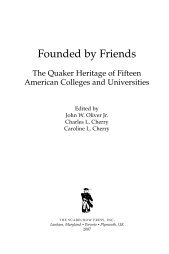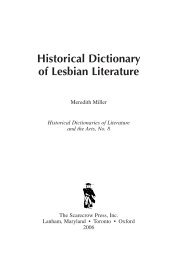Johann Nepomuk Hummel A Musician's Life and ... - Scarecrow Press
Johann Nepomuk Hummel A Musician's Life and ... - Scarecrow Press
Johann Nepomuk Hummel A Musician's Life and ... - Scarecrow Press
Create successful ePaper yourself
Turn your PDF publications into a flip-book with our unique Google optimized e-Paper software.
The Worlds of <strong>Johann</strong> <strong>Nepomuk</strong> <strong>Hummel</strong> 9<br />
eighteenth century. Like his brother-in-law Prince Nikolaus Esterházy II, Grassalkovich<br />
was a devoted patron of music.<br />
17. Karl Wahr had been serving as the director of the theater in <strong>Press</strong>burg since<br />
1773. A renowned actor, Wahr was considered one of the most famous Hamlets of<br />
his time. Benyovsky, J. N. <strong>Hummel</strong>, 20, fn. 3, citing the Gothaer Theaterkalender, 1780.<br />
18. Cited in Karl Benyovsky, <strong>Hummel</strong> und Seine Vaterstadt (Bratislava-<strong>Press</strong>burg:<br />
Sigmund Steiner, 1937), 6–7, <strong>and</strong> Karl Benyovsky, ed., Geschichte der Schaubühne zu<br />
<strong>Press</strong>burg. Zum Vortheil der Henriette Schmidtinn, Einsagerinn bei der Christoph Seippischen<br />
Schauspielergesellschaft, aufgesetzt 1793 (<strong>Press</strong>burg: Eos, 1927). Also cited in<br />
Benyovsky, J. N. <strong>Hummel</strong>, 20, fn. 6. The theater was also the site of many important<br />
theatrical events, among them the first German-language performances of<br />
Shakespeare’s Othello <strong>and</strong> King Lear. Benyovsky, J. N. <strong>Hummel</strong>, 21, fn. 7, citing Karl<br />
Benyovsky, Das alte Theater, Kulturgeschichte Studie aus <strong>Press</strong>burgs Vergangenheit<br />
(Vienna, 1926), 33.<br />
19. For more information about the marriage <strong>and</strong> birth, see Benyovsky, J. N.<br />
<strong>Hummel</strong>, 22 <strong>and</strong> 145. Huttergasse was later renamed <strong>Hummel</strong>gasse, <strong>and</strong> the house<br />
<strong>and</strong> number in Bratislava is currently Klobunická 2. See Zoltan Hrabussay, <strong>Johann</strong><br />
<strong>Nepomuk</strong> <strong>Hummel</strong> und Bratislava (n.p., ca. 1969), 8. This area was once the site of the<br />
Jewish ghetto in <strong>Press</strong>burg.<br />
20. The Wartberg Institute was one of many educational institutions erected by<br />
Maria Theresa as part of her reforms. For example, she established the Theresianum<br />
in 1749 to train young nobles for administration, a “Military Academy” in Wiener<br />
Neustadt (1752) for the training of officers, a “Commercial Academy” for business<br />
education, <strong>and</strong> an “Oriental Academy” to teach diplomats the languages of the<br />
Middle East <strong>and</strong> Asia. By 1747, Maria Theresa had established over five hundred<br />
new primary schools throughout her empire. Consequently, both emperor <strong>and</strong><br />
empress generously supported the Wartberg. See Benyovsky, J. N. <strong>Hummel</strong>, 23, fn.<br />
14, citing the “Austrian War Archives in Vienna, Lit. G. Pag. 1230. Nr. 2238. 8 May<br />
1782.” Hrabussay asserts that <strong>Johann</strong>es assumed the position in 1773. Hrabussay,<br />
<strong>Johann</strong> <strong>Nepomuk</strong> <strong>Hummel</strong> und Bratislava, 3. This is of course incorrect.<br />
21. Max <strong>Johann</strong> Seidel, Biographische Notizen aus dem Leben des am 17ten October<br />
1837 verstorbenen Großherzoglich-Sachsen-Weimarischen Kapellmeister und Ritter<br />
mehrer Orden: <strong>Johann</strong> <strong>Nepomuk</strong> <strong>Hummel</strong>, ersten Klavierspieler seiner Zeit (h<strong>and</strong>written),<br />
1. Original in DÜk, Katalog der Musikalien (Bonn, 1987), no. 2317. Seidel admittedly<br />
exaggerates or colors his narrative at times, very much in the romantic<br />
narrative tradition of the nineteenth century, but his biographical sketch nevertheless<br />
remains a highly important source of information about <strong>Hummel</strong>.<br />
22. Benyovsky, J. N. <strong>Hummel</strong>, 26–27, citing Moritz Müller, “Ein alter Musikmeister,”<br />
Europa, no. 37, 1873.<br />
23. Seidel, Biographische Notizen, 6.<br />
24. The relocation of the Institute took place in 1786 <strong>and</strong> was announced in the<br />
<strong>Press</strong>burger Zeitung of 8 July 1786. Cited in Benyovsky, J. N. <strong>Hummel</strong>, 26, fn. 19.<br />
25. <strong>Johann</strong>es received his offer of employment from <strong>Johann</strong> Friedel <strong>and</strong><br />
Eleonore Schikaneder, the estranged wife of Emanuel Schikaneder, who served as<br />
the directors of the theater that had reopened in 1786 in the Starembergischen Freihaus.<br />
Emanuel Schikaneder ultimately reconciled with his wife <strong>and</strong> on 12 July<br />
1789 assumed the management of the theater, where he would preside over the
















